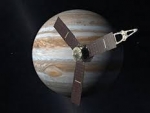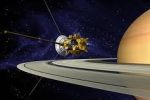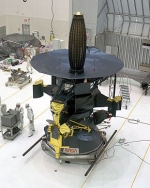Displaying items by tag: Jupiter
Juno spacecraft
Juno is a NASA New Frontiers mission to the planet Jupiter.
Juno was launched from Cape Canaveral Air Force Station on August 5, 2011 and will arrive in July 2016.
The spacecraft is to be placed in a polar orbit to study Jupiter's composition, gravity field, magnetic field, and polar magnetosphere. Juno will also search for clues about how it formed, including whether Jupiter has a rocky core, the amount of water present within the deep atmosphere, and how its mass is distributed. It will also study its deep winds, which can reach speeds of 618 kilometers per hour (384 mph).
recommended: Mission home and videos
JUpiter ICy Moon Explorer (JUICE)
The JUpiter ICy Moon Explorer (JUICE) is a planned European Space Agency (ESA) spacecraft to visit the Jovian system, focused in particular on studying three of Jupiter's moons; Ganymede, Callisto, and Europa.
It will characterise these worlds, all thought to have significant bodies of liquid water beneath their surfaces, as potentially habitable environments.
JUICE is the first large-class mission in ESA's Cosmic Vision 2015-2025 programme. Planned for launch in 2022 and arrival at Jupiter in 2030, it will spend at least three years making detailed observations of the giant gaseous planet Jupiter and three of its largest moons, Ganymede, Callisto and Europa.
Cassini–Huygens (spacecraft)
Cassini–Huygens is a NASA-ESA-ASI robotic spacecraft sent to the Saturn system. It has studied the planet and its many natural satellites since arriving there in 2004, also observing Jupiter, the Heliosphere, and testing the theory of relativity. Launched in 1997 after nearly two decades of gestation, it includes a Saturn orbiter (called Cassini) and an atmospheric probe/lander for the moon Titan (called Huygens), which entered and landed on Titan in 2005. Cassini is the fourth space probe to visit Saturn and the first to enter orbit, and its mission is ongoing as of 2012.
It was launched on October 15, 1997 and entered into orbit around Saturn on July 1, 2004, after an interplanetary voyage which included flybys of Earth, Venus, and Jupiter.
On December 25, 2004, Huygens separated from the orbiter at approximately 02:00 UTC. It reached Saturn's moon Titan on January 14, 2005, when it entered Titan's atmosphere and descended downward to the surface. It successfully returned data to Earth, using the orbiter as a relay. This was the first landing ever accomplished in the outer Solar System.
Sixteen European countries and the United States make up the team responsible for designing, building, flying and collecting data from the Cassini orbiter and Huygens probe. The mission is managed by NASA’s Jet Propulsion Laboratory in the United States. Huygens was developed by the European Space Research and Technology Centre, whose prime contractor was Alcatel of France. Equipment and instruments for the probe were supplied by many countries. The Italian Space Agency (ASI) provided the Cassini probe's high-gain radio antenna, and a compact and lightweight radar, which serves as a synthetic aperture radar, a radar altimeter, and a radiometer.
Galileo (NASA spacecraft)
The Galileo spacecraft was an unmanned spacecraft sent by NASA to study the planet Jupiter and its moons. Named after the astronomer and Renaissance pioneer Galileo Galilei, it was launched on October 18, 1989 by the Space Shuttle Atlantis on the STS-34 mission. It arrived at Jupiter on December 7, 1995, a little more than six years later, via gravitational assist flybys of Venus and Earth.
Despite suffering from antenna problems, Galileo conducted the first asteroid flyby near 951 Gaspra, discovered the first asteroid moon, Dactyl, around the asteroid 243 Ida, and was the first spacecraft to orbit Jupiter. It furthermore launched the first probe into Jupiter's atmosphere.
The spacecraft measured the atmospheric composition of Jupiter and directly observed ammonia clouds, which seem to be created by an outflow from the lower depths of Jupiter's atmosphere. Galileo also registered Io's volcanism and the plasma interactions between its and Jupiter's atmospheres. Other studies gave support for the popular theory of liquid oceans under the icy surface of Europa. There were also indications of similar liquid-saltwater layers under the surfaces of Ganymede and Callisto, while Ganymede was shown to possess a magnetic field. New evidence was also found for the existence of exospheres around Europa, Ganymede, and Callisto.
It was furthermore discovered that Jupiter's faint ring system is formed by dust from impacts on the four small inner moons. The extent and structure of Jupiter's magnetosphere was also mapped.
Galileo also provided the only direct observation of Comet Shoemaker-Levy 9's impact into the atmosphere of Jupiter in 1994.
On September 21, 2003, after 14 years in space and 8 years of service in the Jovian system, Galileo's mission was terminated by sending the orbiter into Jupiter's atmosphere at a speed of nearly 50 kilometres per second to avoid any chance of it contaminating local moons with bacteria from Earth. Of particular concern was the ice-crusted moon Europa, which, thanks to Galileo, scientists now suspect harbors a potentially life-supporting saltwater ocean beneath its surface.




